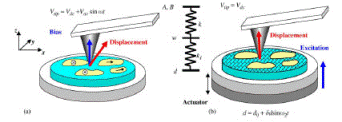Department of Physics and Astronomy: Publications and Other Research
Date of this Version
January 2007
Abstract
Progress in modem science is impossible without reliable tools for characterization of structural, physical, and chemical properties of materials and devices at the micro-, nano-, and atomic scale levels. While structural information can be obtained by such established techniques as scanning and transmission electron microscopy, high-resolution examination of local electronic structure, electric potential and chemical functionality is a much more daunting problem. Local electronic properties became accessible after the development of Scanning Tunneling Microscopy by G. Binnig and H. Rohrer in 1981 at IBM Zurich 25 years ago-an invention that earned its authors the Nobel Prize in Physics five years later [1]. Based on the quantum mechanical tunneling between an atomically sharp metallic tip and conductive surface, scanning tunneling microscopy (STM) has become the first instrument to generate real-space images of surfaces with atomic resolution and has triggered development of new classes of STM-related techniques. In 1986, Binnig, Quate, and Gerber demonstrated atomic force microscope (AFM) based on the mechanical detection of the Van der Waals forces between the tip and the surface using a pliable cantilever [2]. It was almost immediately realized that AFM could be extended to map forces of various types, such as magnetic and electrostatic forces, as well as for probing chemical interactions. This dual capability of probing currents and forces at the nanometer and atomic level has led to a rapid growth of a variety of scanning probe microscopy (SPM) techniques over the last two decades. Techniques such as AFM, magnetic force microscopy (MFM), electrostatic force microscopy (EFM), scanning capacitance microscopy (SCM), near-field scanning optical microscopy (NSOM), and others have emerged to provide capability to access local electrical, magnetic, chemical, mechanical, optical, and thermal properties of materials on the nanometer scale. It has been demonstrated that the SPM approach allows not only imaging, but also control and modification of the local structure and material functionality at the nano- and atomic level. As a consequence, the last two decades have witnessed an explosive growth in application of SPM techniques in a wide spectrum of fields of science, ranging from condensed matter physics, chemistry and materials science to medicine and biology. It will not be an exaggeration to say that the rapid development of nanoscience and nanotechnology in the last two decades was strongly stimulated by the availability of SPM techniques, and in turn constantly stimulates development of novel SPM probes.


Comments
Published in Scanning Probe Microscopy: Electrical and Electromechanical Phenomena at the Nanoscale, Sergei Kalinin and Alexei Gruverman, editors, 2 volumes (New York: Springer Science+Business Media, 2007). Used by permission.